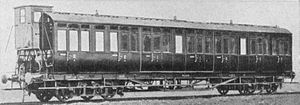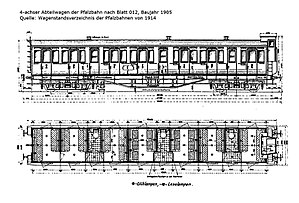B4 bay 05b
| B4 bay 05b | |
|---|---|
|
Compartment car according to ABB Sheet 12 of
the Palatinate car register from 1913 |
|
| Number: | 6th |
| Manufacturer: | Rastatt |
| Year of construction (s): | 1905 |
| Axis formula : | FIG |
| Type : | Bogie compartment car |
| Genre : | ABB, later B4 |
| Gauge : | 1435 mm ( standard gauge ) |
| Length over buffers: | 18,660 mm |
| Length: | 16,960 mm |
| Height: | 4,135 mm |
| Width: | 2,600 mm |
| Trunnion Distance: | 12,250 mm |
| Bogie axle base: | 2,500 mm |
| Wheel diameter: | 1,014 mm |
| Brake: | Type Schleiffer |
| Train heating: | steam |
| Coupling type: | Rod buffer |
| Seats: | 10/34 |
| Classes : | 1 and 2. |
The B4 Bay 05 were compartment wagons , which were originally built as type ABB for the Palatinate Railways . This type of wagon is shown on sheet 12 of the 1913 Palatinate wagon directory.
History / procurement
As with most of the southern German railway companies, the type of compartment car was the predominant type of car on the Palatinate Railways , but until the 1890s it was only a two- and three-axle vehicle. With the advent of supraregional passenger and express trains - international express trains have also been running through the Palatinate since 1895 - the management of the Pfalzbahn needed to procure suitable rolling stock, also with regard to the wagon compensation agreed with the neighboring railways.
In 1905, a total of 6 first and second class wagons were procured from the Rastatt wagon factory for upscale passenger and express train services. With the takeover of the Pfalzbahnen by the Royal Bavarian State Railways in 1909, these wagons were also taken over and assigned to the Ludwigshafen management of KBSts.EB. With the transition to the Reichsbahn in 1920, the compartments of the first class were changed to those of the second and the cars were given the class designation B4 Bay 05b . The further whereabouts are unclear, as the DRG did not list the wagons of the former Palatinate Railways separately.
Constructive features
Underframe
The frame consisted of riveted rolled sections. The outer side rails were U-shaped with outward-facing flanges. To support the car body and due to the large pivot spacing, a truss frame made of profiles and pillar stands was installed in the plane of the outer side members. As a towing device, the wagons had screw couplings with safety hooks according to VDEV , the drawbar was spring-loaded throughout. The wagons were equipped with rod buffers with an installation length of 650 mm, the buffer plates had a diameter of 370 mm. These were later partly replaced by case buffers .
drive
The cars had bogies of Bavarian design with a short wheelbase and frames riveted from sheet metal and angles. The axles were stored in sliding axle bearings. The wheels had spoked wheel bodies and a wheel diameter of 1,014 mm.
Brake: Pneumatic brake system Schleiffer, hand brake in the raised brakeman's cab.
Car body
Shell: car body frame made of wood, clad on the outside with sheet metal and inside with wood. Side walls slightly drawn in on the underside, barrel roof. Raised brakeman's cab, accessible from both sides, with a flat arched roof. No transition on the front sides.
Furnishing
Interior: a total of seven compartments, two of the 1st and five of the 2nd class. 1st class compartments in the middle of the car. A total of three toilets with washing facilities. One of the toilets could be reached from each compartment through side passages. The car had padded seats.
Heating: The vehicles had steam heating .
Ventilation: static fans on the roof.
Lighting: originally the lighting was gas, the storage container hung on the frame in the longitudinal direction of the car. Later partially electric lighting.
comment
With the transition to DRG, the two compartments of the first class without changing the seat allocation were redrawn to those of the second class, and the cars were given a modified generic name .
Wagon numbers
| Sheet number. Manufacturing |
Generic symbols per epoch Car numbers per epoch (with information about the direction) |
landing gear | Furnishing | Additional information | |||||||||||||||||||
|---|---|---|---|---|---|---|---|---|---|---|---|---|---|---|---|---|---|---|---|---|---|---|---|
|
construction year |
manufacturers manufacturers |
Number |
from 1876 |
from 1907 |
Rep. 1919 |
DR (from 1923) |
DRG (from 1930) |
DRG after renovation |
excluded screened |
last. Home letter |
Number Ax. |
Unt. Gest. |
LA. |
Brem- sen |
Bl. | Hz. |
Number off place |
Seats per class (mil. Usage) |
Sig- nal . |
comment | |||
| Sheet number. 12 | FIG | FROM 4 | B4 bay 05b | B4 bay 05b | (see respective legend) | 1. | 2. | 3. | 4th |
(see legend ) |
Procurement of the Ludwig Railway | ||||||||||||
| 1905 | Rest. | 6th | 13 | 13 | 4th | E. | Brh; Sbr; | Tbsp | D. | 3 | 10 | 34 (34) |
with a raised brakeman's cab | ||||||||||
| 22nd | 22nd | ||||||||||||||||||||||
| 23 | 23 | ||||||||||||||||||||||
| 26th | 26th | ||||||||||||||||||||||
| 27 | 27 | ||||||||||||||||||||||
| 34 | 34 | ||||||||||||||||||||||
Individual evidence
- ↑ The data are taken from the rolling stock registers of the Royal Bavarian State Railways, drawn up as of March 31, 1897 and 1913
literature
- Emil Konrad: The passenger coaches of the German national railways . 1st edition. Franckh'sche Verlagshandlung W. Keller & Co., Stuttgart 1984, ISBN 3-440-05327-X .
- Vehicle fleet directory of the Royal Bavarian State Railways - Palatinate network . 1913 (compiled from March 31, 1913).
- Albert Mühl: The Pfalzbahn . 1st edition. Konrad Theiss, Stuttgart 1982, ISBN 3-8062-0301-6 .

